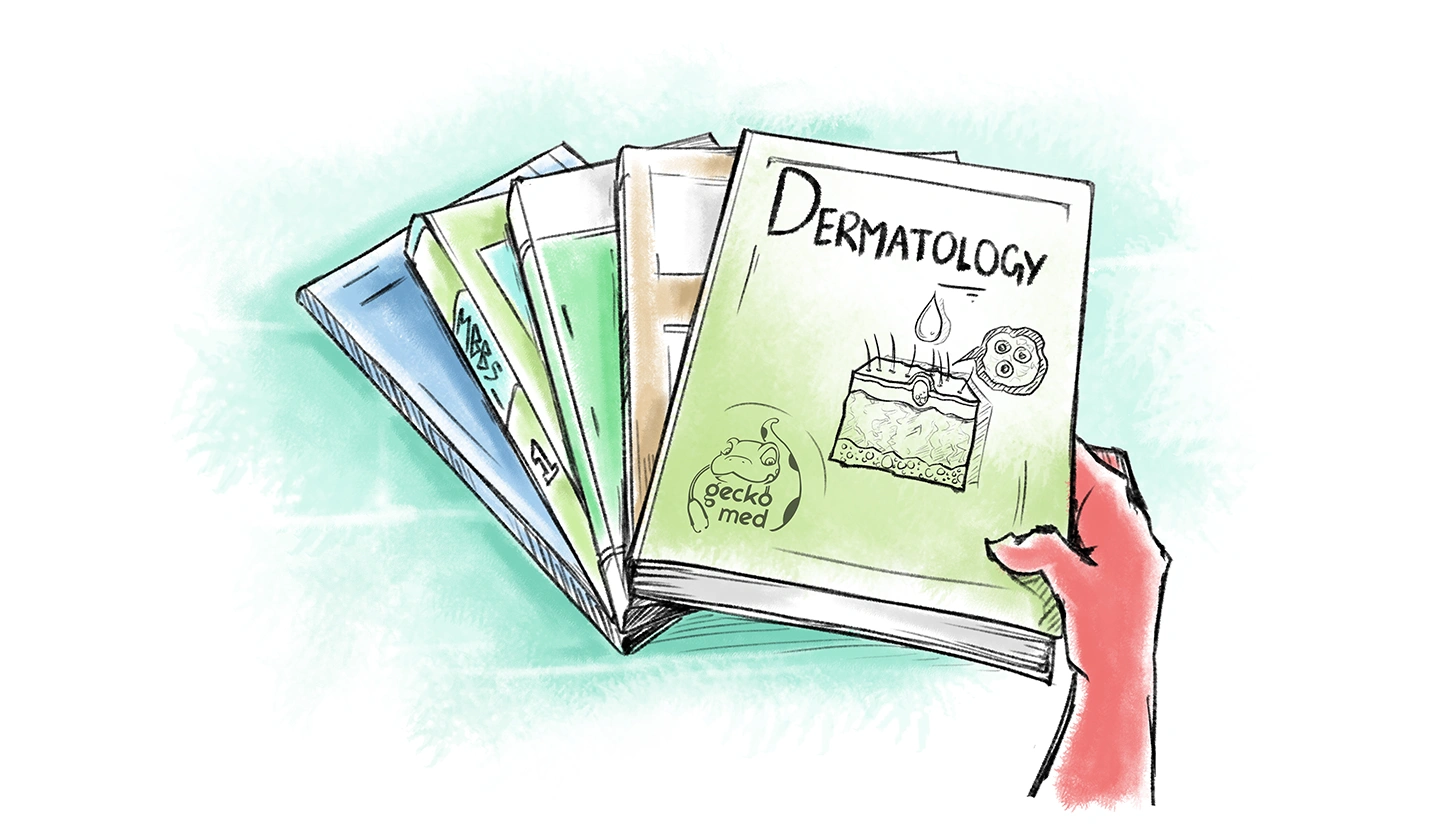Dermatology is all about understanding skin, hair, and nails, and it’s a pretty broad field. As an MBBS student diving into this specialty, you’ll come across a wide range of conditions, diagnostic methods, and treatments.
To master it all, you’ll need learning resources that fit your style and give you the quality information you need.
This guide walks you through the top dermatology books, with reviews, comparisons, and insights to help you choose the right one for your studies.
Dermatology Books for MBBS: Textbooks
Textbooks form the cornerstone of medical education, providing a structured and comprehensive overview of the subject matter.
In dermatology, a good textbook is essential for building a strong foundation and understanding the basic principles of skin health and disease.
1) Illustrated Synopsis of Dermatology and Sexually Transmitted Diseases by Neena Khanna
This book is a highly popular choice among Indian medical students, and for good reason.
Dr. Neena Khanna, a renowned dermatologist and author, has tailored this book specifically to the Indian context, making it highly relevant for students studying and practicing in India.
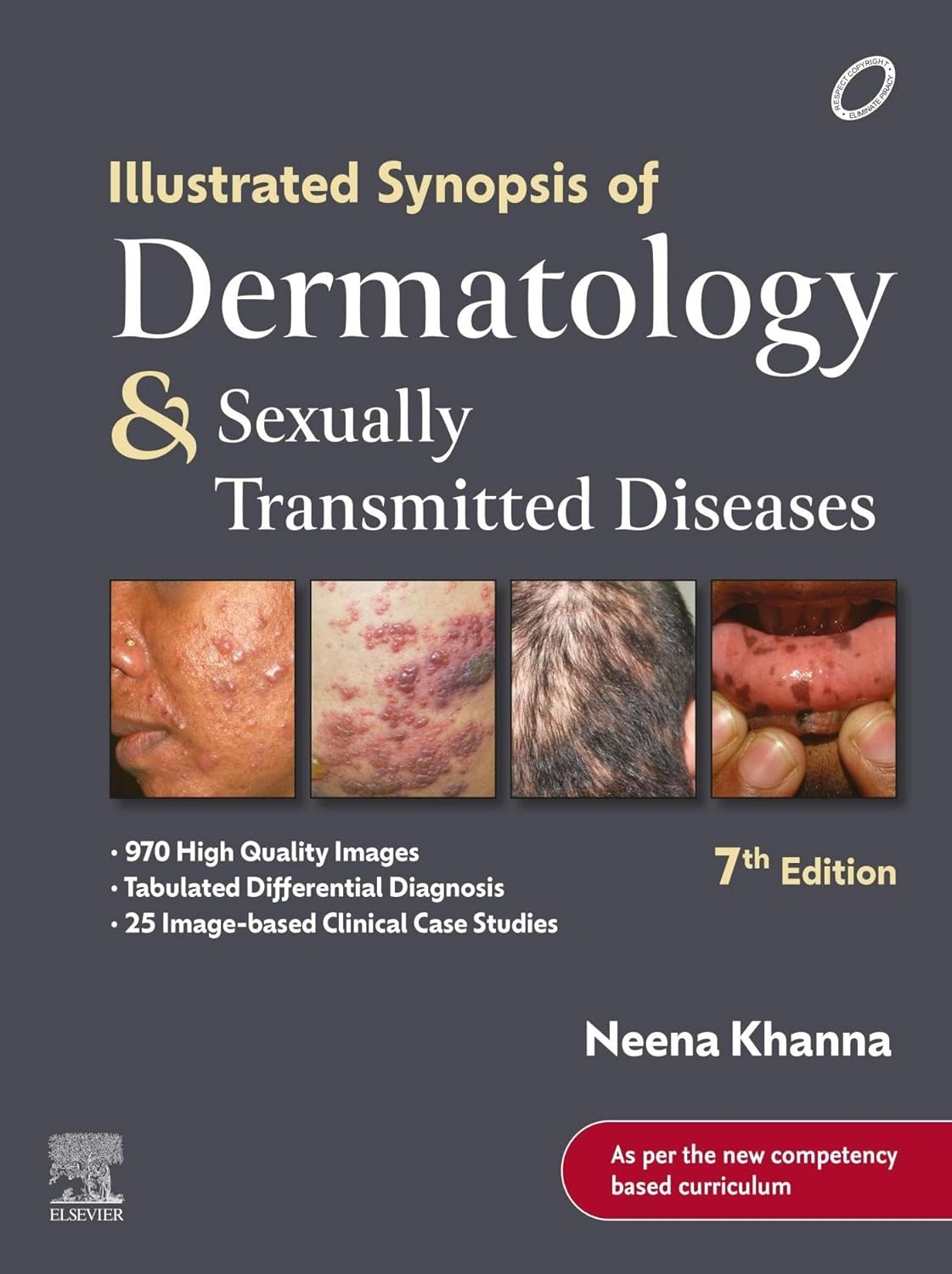
Strengths:
- Relevance to the Indian context: This book stands out for its focus on skin diseases prevalent in India. It includes detailed discussions on conditions like leprosy, cutaneous tuberculosis, and fungal infections, which are more commonly seen in the Indian population. This focus ensures that students are well-prepared to diagnose and manage these conditions in their clinical practice.
- Exam-oriented approach: The book is structured in a clear and concise manner, making it ideal for exam preparation. It covers all the essential topics in dermatology, with key concepts highlighted and summarized for easy recall. This approach helps students focus their efforts and effectively prepare for examinations.
- Richly illustrated: The book features a wealth of high-quality images and illustrations. These visuals are invaluable for understanding the clinical presentation of various skin diseases and developing diagnostic skills. The images also make the learning process more engaging and enjoyable.
- Comprehensive coverage of sexually transmitted diseases (STDs): The book includes a dedicated section on STDs, recognizing their importance in dermatological practice. This section provides a comprehensive overview of common STDs, their clinical features, diagnosis, and management. This is crucial for MBBS students, as they will encounter these conditions in their clinical practice.
- Concise and easy to read: The writing style is clear and concise, making the book easy to understand and navigate. This is particularly helpful for students who are new to dermatology and may find the subject matter overwhelming.
- Includes recent advances: The latest edition incorporates recent advances in dermatology, including new treatment modalities and diagnostic techniques. This ensures that students are up-to-date with the latest developments in the field.
- Affordable price: Compared to many international textbooks, this book is relatively affordable, making it accessible to a wider range of students.
Weaknesses:
- May lack the depth of international textbooks: While excellent for foundational knowledge and exams, it may not delve as deeply into certain topics as some of the larger international textbooks. Students seeking more in-depth information on specific conditions or treatment modalities may need to consult additional resources.
- Focus on common conditions: The book primarily focuses on common skin diseases encountered in India. While this is beneficial for most students, those interested in rarer dermatological conditions may need to refer to specialized texts.
2) Textbook of Dermatology by Rook, Wilkinson, and Ebling
This is a classic textbook that has been a cornerstone of dermatology education for generations of medical students.
Known for its comprehensive coverage and authoritative voice, it remains a highly respected resource in the field.

Strengths:
- Comprehensive and in-depth: This textbook provides an exhaustive overview of dermatology, covering a wide range of topics in detail. It delves into the pathophysiology, clinical features, diagnosis, and management of various skin diseases, offering a comprehensive understanding of the subject.
- Well-respected and authoritative: Rook’s Textbook of Dermatology is widely regarded as a definitive resource in the field. It is authored by leading experts in dermatology and is trusted by dermatologists worldwide.
- Strong emphasis on basic science: The book provides a solid foundation in the basic science of dermatology, including skin anatomy, physiology, and immunology. This foundation is essential for understanding the pathogenesis of skin diseases and the rationale behind treatment approaches.
- Includes historical perspectives: The book offers valuable historical perspectives on the evolution of dermatology, providing context and insights into the development of current knowledge and practices.
- Extensive references: Each chapter includes extensive references to original research articles and reviews, allowing students to delve deeper into specific topics and explore the latest scientific evidence.
Weaknesses:
- Can be dense and challenging for beginners: The language and depth of information can be overwhelming for students new to dermatology. The book’s comprehensive nature can make it challenging to navigate and identify key information.
- Less focus on clinical images: Compared to some other textbooks, Rook’s may have fewer clinical images. While the text provides detailed descriptions, visual learners may benefit from supplementing with an atlas or online resources.
- High cost: This textbook is relatively expensive compared to other options.
3) Dermatology by Jean L. Bolognia, Joseph L. Jorizzo, Julie V. Schaffer
This textbook is highly acclaimed for its clear and engaging writing style, its emphasis on clinical application, and its stunning visuals.
It is a popular choice among students and clinicians alike.

Strengths:
- Clear and engaging writing style: The authors have a knack for explaining complex concepts in a clear and accessible manner. This makes the book enjoyable to read and facilitates understanding, even for those new to dermatology.
- Strong clinical focus: The book emphasizes the clinical application of dermatological knowledge. It connects basic science concepts to real-world clinical scenarios, helping students bridge the gap between theory and practice.
- Exceptional illustrations: The book is richly illustrated with high-quality photographs, diagrams, and clinical images. These visuals are carefully selected to enhance understanding and aid in visual diagnosis.
- Well-organized and easy to navigate: The content is logically organized and easy to navigate, with clear headings, subheadings, and tables. This makes it easy for students to find the information they need quickly and efficiently.
- Includes online resources: The book comes with access to online resources, including self-assessment quizzes, case studies, and additional images. These resources provide valuable opportunities for students to test their knowledge and apply what they have learned.
Weaknesses:
- May not be as exhaustive as Rook’s: While comprehensive, it may not cover some topics in as much depth as Rook’s Textbook of Dermatology. Students seeking the most comprehensive coverage may need to consult additional resources.
- High cost: Similar to Rook’s, this textbook is also relatively expensive.
4) Andrews’ Diseases of the Skin: Clinical Dermatology by William D. James, Timothy G. Berger, Dirk M. Elston
This textbook is known for its concise and clinically oriented approach, making it a popular choice for students seeking a more streamlined resource.
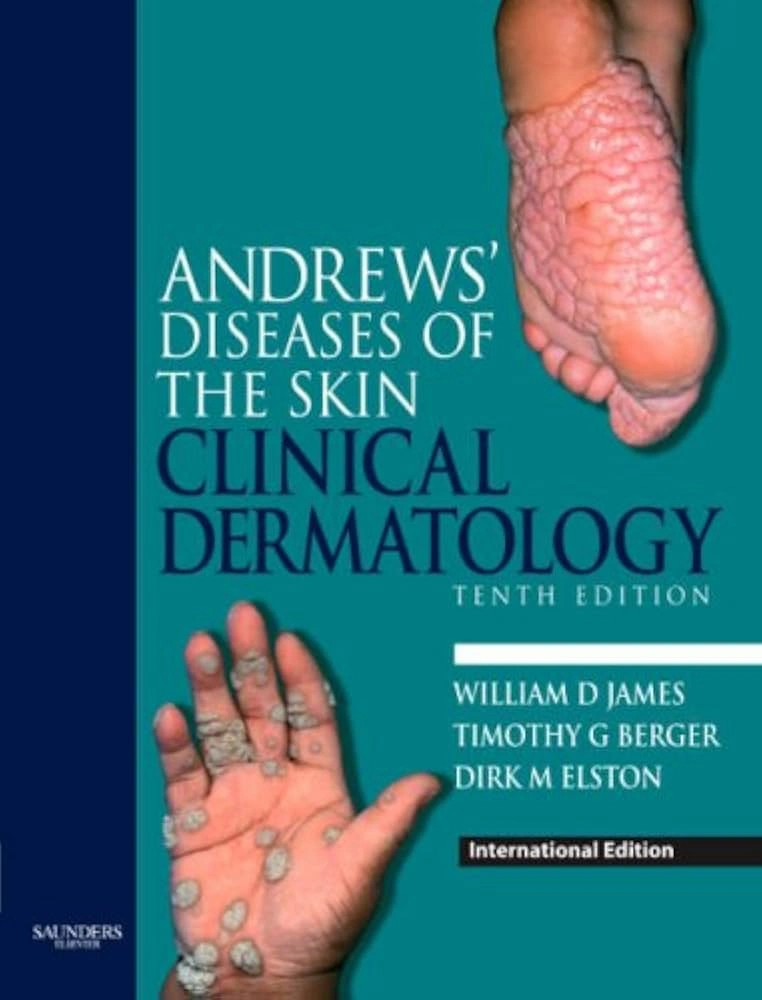
Strengths:
- Concise and easy to read: The book presents information in a concise and straightforward manner, making it easy to digest and retain. This is particularly helpful for students who prefer a more focused approach to learning.
- Strong clinical emphasis: The book prioritizes clinical information, providing practical guidance on the diagnosis and management of common skin diseases. This makes it a valuable resource for clinical rotations and exam preparation.
- Well-organized and user-friendly: The content is organized logically, with clear headings, bullet points, and tables. This makes it easy to find specific information quickly.
- Includes helpful algorithms and tables: The book incorporates numerous algorithms and tables to aid in differential diagnosis and treatment decision-making. These visual aids simplify complex information and enhance understanding.
- More affordable: Compared to some of the larger textbooks, Andrews’ Diseases of the Skin is more affordable, making it a good option for students on a budget.
Weaknesses:
- May lack the depth of other textbooks: Due to its concise nature, the book may not provide as much detail on certain topics as larger textbooks like Rook’s or Bolognia’s. Students seeking more in-depth information may need to consult additional resources.
- Fewer images compared to some other texts: While the book includes clinical images, it may not have as many as some other textbooks. Visual learners may benefit from supplementing with an atlas or online resources.
5) Fitzpatrick’s Dermatology in General Medicine by Klaus Wolff, Lowell A. Goldsmith, Stephen I. Katz, Barbara A. Gilchrest
This textbook takes a unique approach by emphasizing the connection between skin diseases and systemic conditions.
It highlights the importance of considering the whole patient when evaluating and managing dermatological problems.
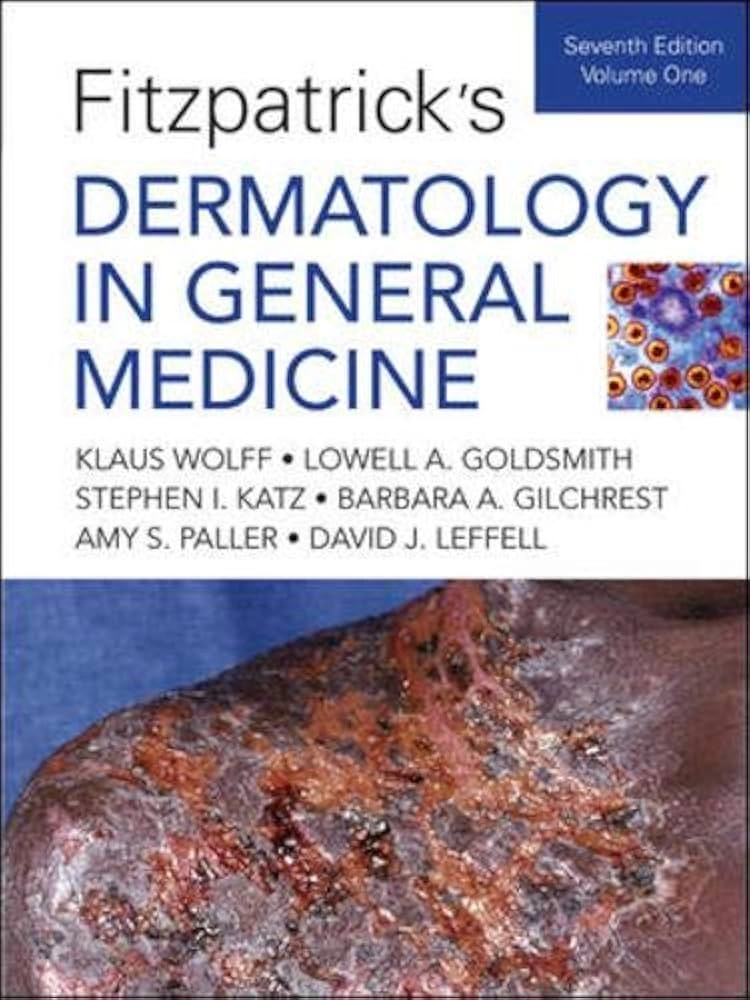
Strengths:
- Integrates dermatology with internal medicine: This book bridges the gap between dermatology and internal medicine, demonstrating how skin manifestations can be indicative of underlying systemic diseases. This integrated approach is crucial for developing a holistic understanding of patient care.
- Comprehensive coverage of dermatological manifestations of systemic diseases: The book provides detailed information on how various systemic diseases, such as lupus, diabetes, and HIV, can affect the skin. This is essential knowledge for any physician, as skin findings can often provide valuable clues to underlying medical conditions.
- Authored by leading experts: Fitzpatrick’s Dermatology in General Medicine is written by renowned experts in both dermatology and internal medicine, ensuring the accuracy and authority of the information.
- Includes valuable tables and charts: The book incorporates numerous tables and charts that summarize key information, such as the dermatological manifestations of various systemic diseases and differential diagnoses. These visual aids enhance understanding and facilitate quick reference.
Weaknesses:
- Less focus on common skin conditions: While the book covers common skin conditions, its primary focus is on the dermatological manifestations of systemic diseases. Students may need to consult other resources for more detailed information on common skin problems.
- High cost: This textbook is one of the more expensive options on the market.
To enhance your visual learning, consider using dermatology atlases.
Dermatology Books for MBBS: Atlases
Atlases are indispensable tools for visual learners in dermatology. They provide a wealth of high-quality images that showcase the diverse manifestations of skin diseases.
By studying these images, students can develop their pattern recognition skills and improve their diagnostic accuracy.
1) Color Atlas of Dermatology by Anthony du Vivier
This atlas is known for its comprehensive coverage and its inclusion of a wide variety of skin conditions, making it a valuable tool for self-assessment and exam preparation.
Strengths:
- Comprehensive coverage: The atlas includes a vast collection of images representing a wide range of skin conditions, from common to rare. This ensures that students are exposed to a diverse range of clinical presentations.
- Good for self-assessment: The atlas includes self-assessment questions and case studies, allowing students to test their knowledge and diagnostic skills. This interactive approach reinforces learning and helps students identify areas where they need further study.
- Includes images of different skin types: The atlas features images of skin conditions on individuals with diverse skin types, highlighting the variations in clinical presentation across different populations.
- Organized by body region: The atlas is organized by body region, making it easy to find images relevant to specific clinical scenarios.
Weaknesses:
- Image quality may vary: While the atlas includes a large number of images, the quality can vary. Some images may not be as clear or detailed as those in other atlases.
- Limited text: Similar to other atlases, the text accompanying each image is limited. Students may need to consult other resources for more detailed information.
2) Atlas of Clinical Dermatology by David J. Gawkrodger
This atlas is praised for its user-friendly format and its organization by body region, making it a practical resource for clinical rotations and bedside learning.
Strengths:
- User-friendly format: The atlas is designed for easy navigation and quick reference. The layout is clear and concise, with images and descriptions presented in a straightforward manner.
- Organized by body region: The organization by body region makes it easy to find images relevant to specific clinical encounters. This is particularly helpful during clinical rotations, where students may need to quickly identify skin conditions on different parts of the body.
- Includes concise and relevant clinical information: Each image is accompanied by a brief description that highlights key clinical features, differential diagnoses, and management considerations. This information is presented in a concise and clinically relevant manner.
- Good for bedside learning: The atlas’s portable size and user-friendly format make it an ideal resource for bedside learning and quick reference during clinical encounters.
Weaknesses:
- May not be as comprehensive as some other atlases: While the atlas covers a wide range of conditions, it may not be as exhaustive as some other atlases that include more images and rarer diseases.
- Image quality may vary: The quality of the images can vary, with some images not being as clear or detailed as those in other atlases.
For specific needs, such as exam preparation or research, you may need specialized books.
Dermatology Books for MBBS: Books for Specific Needs
Beyond textbooks and atlases, several books cater to specific learning needs and interests within dermatology.
These books provide focused information and practical guidance in specific areas, allowing students to delve deeper into topics that resonate with them or align with their career goals.
A. Practical Guides
Practical guides offer concise and clinically relevant information, focusing on the essential knowledge and skills needed for effective patient care.
1) Dermatology: An Illustrated Colour Text by David J. Gawkrodger
This book is a popular choice for students seeking a concise and practical guide to dermatology.
It presents essential information in a clear and accessible manner, making it ideal for exam preparation and clinical practice.
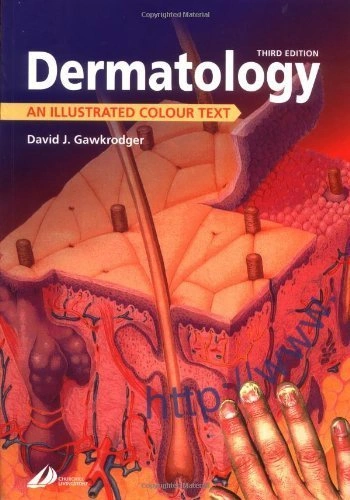
Strengths:
- Concise and easy to understand: The book distills essential dermatological knowledge into a concise and easily digestible format. The writing style is clear and straightforward, making it accessible to students of all levels.
- Focuses on essential clinical information: The book prioritizes clinically relevant information, providing practical guidance on the diagnosis and management of common skin diseases. This makes it a valuable resource for clinical rotations and exam preparation.
- Richly illustrated: The book features numerous high-quality clinical images that illustrate the diverse manifestations of skin diseases. These visuals enhance understanding and aid in visual diagnosis.
- Includes helpful tables and flowcharts: The book incorporates tables and flowcharts to summarize key information and guide clinical decision-making. These visual aids simplify complex information and enhance understanding.
- Affordable price: This book is relatively affordable compared to larger textbooks, making it a good option for students on a budget.
Weaknesses:
- May lack the depth of other textbooks: Due to its concise nature, the book may not provide as much detail on certain topics as larger textbooks like Rook’s or Bolognia’s. Students seeking more in-depth information may need to consult additional resources.
- Limited coverage of rarer conditions: The book primarily focuses on common skin diseases. Students interested in rarer dermatological conditions may need to refer to specialized texts.
2) Clinical Dermatology by John Hunter, John Savin, Mark V. Dahl
This book takes a unique problem-oriented approach to dermatology, presenting clinical scenarios and guiding students through the process of differential diagnosis and management.
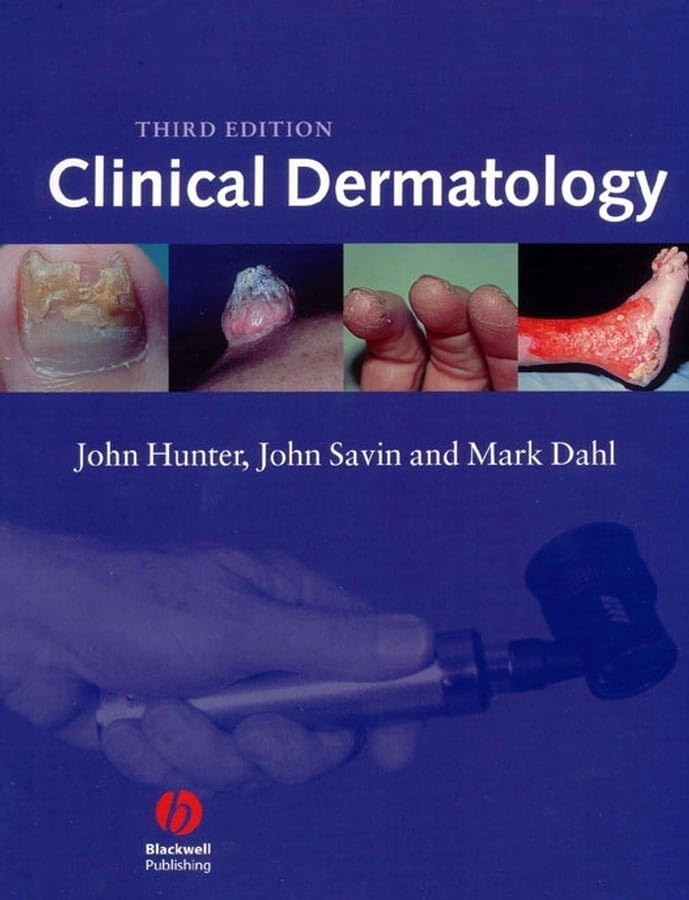
Strengths:
- Problem-oriented approach: The book presents clinical cases and challenges students to develop differential diagnoses and formulate management plans. This active learning approach encourages critical thinking and problem-solving skills.
- Focuses on common clinical presentations: The book covers common clinical presentations in dermatology, helping students develop a practical approach to patient care.
- Includes helpful algorithms and tables: The book incorporates algorithms and tables to aid in differential diagnosis and treatment decision-making. These visual aids simplify complex information and enhance understanding.
- Emphasizes clinical reasoning: The book encourages students to think critically about clinical presentations and develop a systematic approach to diagnosis and management.
Weaknesses:
- May not be as comprehensive as some textbooks: The book’s focus on common clinical presentations may limit its coverage of rarer dermatological conditions.
- Limited basic science information: The book primarily focuses on clinical aspects, with less emphasis on basic science concepts. Students may need to consult other resources for a more comprehensive understanding of the underlying mechanisms of skin diseases.
B. Review Books
Review books are invaluable tools for consolidating knowledge and preparing for exams.
They provide concise summaries of key concepts and offer opportunities for self-assessment.
1) Dermatology Recall by Adam Rubin
This book is a popular choice for students seeking a rapid-fire review of essential dermatology concepts.
It presents information in a question-and-answer format, making it ideal for quick revision and self-testing.
Strengths:
- Excellent for quick revision: The book condenses essential dermatology information into a concise format, making it ideal for quick review sessions.
- Question-and-answer format: The book uses a question-and-answer format to present information, allowing students to test their knowledge and identify areas where they need further study. This interactive approach reinforces learning and enhances retention.
- Covers key concepts and facts: The book covers all the essential concepts and facts in dermatology, ensuring that students have a solid grasp of the fundamentals.
- Portable and easy to use: The book’s small size and concise format make it easy to carry around and use for quick review sessions during commutes or breaks.
Weaknesses:
- Limited explanations: Due to its focus on rapid review, the book may not provide detailed explanations of all concepts. Students may need to consult other resources for more in-depth information.
- May not be suitable for in-depth learning: The book’s concise nature makes it less suitable for in-depth learning or as a primary study resource.
2) Illustrated Questions in Dermatology by David J. Gawkrodger
This book uses a case-based approach to test students’ knowledge and application skills in dermatology. It presents clinical scenarios and challenges students to apply their knowledge to diagnose and manage real-world cases.
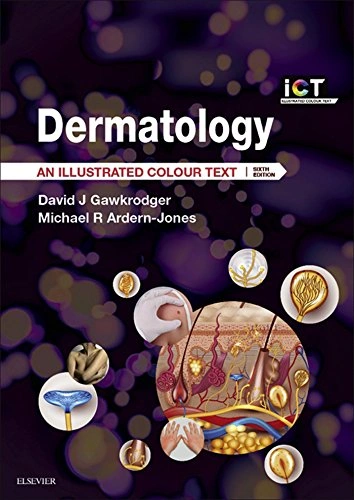
Strengths:
- Case-based approach: The book presents clinical cases with accompanying images, allowing students to apply their knowledge to real-world scenarios. This active learning approach promotes critical thinking and problem-solving skills.
- Covers a wide range of cases: The book includes a diverse range of cases, covering common and less common skin conditions. This ensures that students are exposed to a variety of clinical presentations and challenges.
- Includes detailed explanations: Each case is followed by detailed explanations of the diagnosis, differential diagnoses, and management options. This provides valuable insights and reinforces learning.
- Promotes clinical reasoning: The book encourages students to think critically about clinical presentations and develop a systematic approach to diagnosis and management.
Weaknesses:
- May not be suitable for initial learning: The book’s focus on case-based learning makes it more suitable for students who already have a foundational knowledge of dermatology.
- Limited basic science information: The book primarily focuses on clinical aspects, with less emphasis on basic science concepts.
C. Specialized Texts
Specialized texts delve into specific areas of dermatology, providing in-depth information and guidance for students interested in pursuing particular subspecialties or research areas.
1) Pediatric Dermatology by Lawrence A. Schachner, Ronald C. Hansen
This book is a comprehensive resource for students and clinicians interested in the diagnosis and management of skin diseases in children.
It covers a wide range of topics, from common skin conditions to rare and complex disorders.
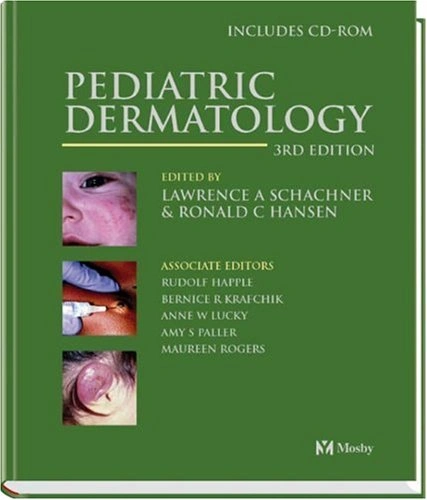
Strengths:
- Comprehensive coverage of pediatric skin diseases: The book provides detailed information on the unique characteristics of skin diseases in children, including their clinical presentation, diagnosis, and management.
- Includes chapters on specific pediatric dermatological conditions: The book includes dedicated chapters on specific pediatric dermatological conditions, such as atopic dermatitis, hemangiomas, and genetic skin disorders.
- Authored by leading experts in pediatric dermatology: The book is written by renowned experts in pediatric dermatology, ensuring the accuracy and authority of the information.
- Includes valuable tables and charts: The book incorporates numerous tables and charts that summarize key information, such as differential diagnoses and treatment options.
- Richly illustrated: The book features numerous high-quality clinical images that illustrate the diverse manifestations of pediatric skin diseases.
Weaknesses:
- May be too specialized for students seeking a general overview of dermatology: The book’s focus on pediatric dermatology may make it less suitable for students seeking a general overview of the field.
- High cost: This book is relatively expensive compared to some other dermatology texts.
2) Dermatologic Surgery by Leonard Dzubow
This book is a comprehensive guide to surgical procedures in dermatology, covering a wide range of techniques, from basic biopsies to complex reconstructive procedures.
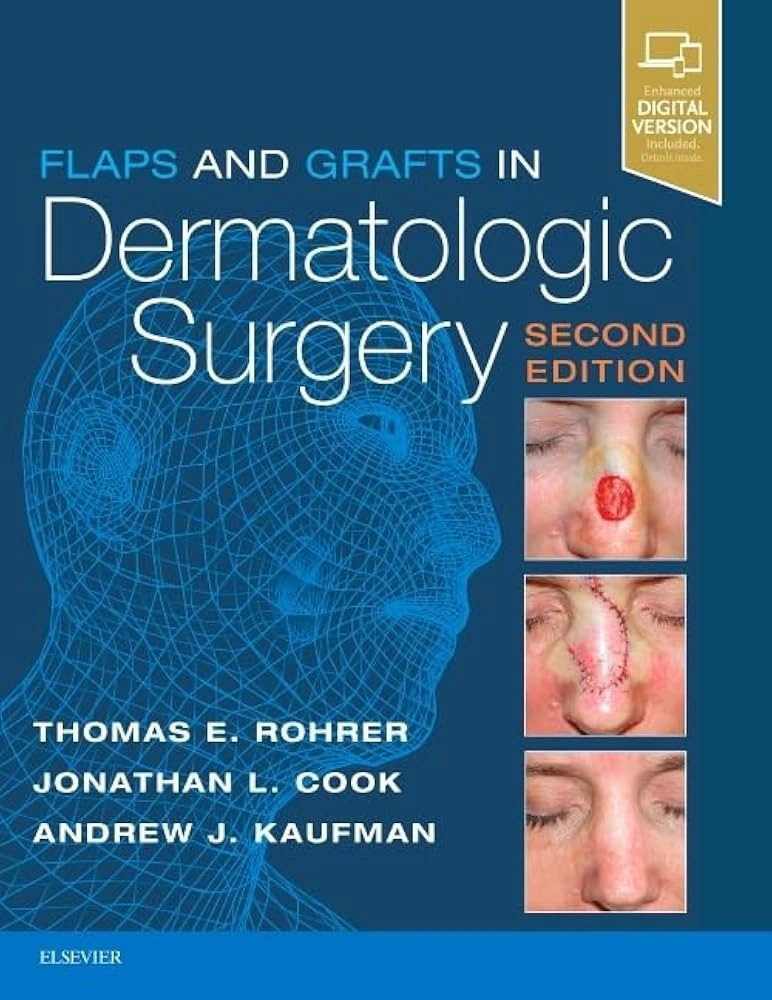
Strengths:
- Comprehensive coverage of dermatologic surgical procedures: The book provides detailed information on various surgical techniques used in dermatology, including biopsies, excisions, flaps, and grafts.
- Includes step-by-step instructions and illustrations: The book features clear step-by-step instructions and illustrations that guide readers through the various surgical procedures.
- Covers both basic and advanced techniques: The book covers both basic and advanced surgical techniques, making it suitable for students at all levels of training.
- Authored by a leading expert in dermatologic surgery: The book is written by a renowned expert in dermatologic surgery, ensuring the accuracy and authority of the information.
Weaknesses:
- May be too specialized for students not interested in dermatologic surgery: The book’s focus on surgical procedures may make it less suitable for students who are not interested in pursuing a career in dermatologic surgery.
- High cost: This book is relatively expensive compared to some other dermatology texts.
To make the most of your textbooks, it’s important to choose the right ones for your learning style.
Tips for Choosing Dermatology Books for MBBS
Choosing the right dermatology books can significantly impact your learning experience and academic success. Here are some tips to help you make informed decisions:

1) Consider your learning style: Are you a visual learner who benefits from images and diagrams? Do you prefer concise summaries or detailed explanations? Choose books that match your learning preferences and style.
2) Prioritize books with clear explanations and good illustrations: Look for books that present information in a way that is easy to understand and visually engaging. Clear explanations and high-quality illustrations can significantly enhance your learning and retention.
3) Look for books that align with your curriculum and exam pattern: Make sure the books you choose cover the topics you need to know for your exams and align with the specific requirements of your curriculum.
4) Read reviews and seek recommendations from seniors or faculty: Get insights from others who have used the books you are considering. Online reviews and recommendations from seniors or faculty can provide valuable perspectives and help you make informed choices.
5) Consider the book’s format and accessibility: Think about whether you prefer print books or digital formats. Also, consider the book’s accessibility, such as font size and layout, especially if you have any visual impairments.
6) Balance cost and value: While cost is an important consideration, prioritize the book’s value and relevance to your needs. Investing in a high-quality textbook that you will use extensively can be a worthwhile investment in your education.
By carefully selecting and utilizing these resources, you can enhance your understanding of dermatology and achieve academic success.
Conclusion
Choosing the right dermatology books and resources is crucial for your success as an MBBS student.
By understanding your learning style, prioritizing clear explanations and good illustrations, and considering your specific needs and interests, you can select the resources that will best support your journey in mastering this fascinating field of medicine.
Remember to utilize a combination of textbooks, atlases, and online resources to gain a comprehensive understanding of dermatology and develop the knowledge and skills needed for clinical practice.

